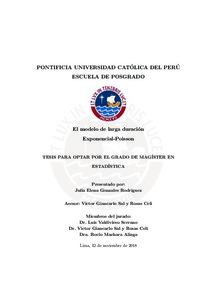| dc.contributor.advisor | Sal y Rosas Celi, Víctor Giancarlo | |
| dc.contributor.author | Gonzales Rodriguez, Julia Elena | es_ES |
| dc.date.accessioned | 2018-12-03T17:40:47Z | es_ES |
| dc.date.available | 2018-12-03T17:40:47Z | es_ES |
| dc.date.created | 2018 | es_ES |
| dc.date.issued | 2018-12-03 | es_ES |
| dc.identifier.uri | http://hdl.handle.net/20.500.12404/13062 | |
| dc.description.abstract | En esta tesis se introducir y estudiar el modelo de supervivencia de larga duración
Exponencial-Poisson. Este modelo permite estudiar el tiempo hasta la ocurrencia de un evento
de interés cuando se asume que existe una fracción de unidades de la población inmunes a
la ocurrencia de este evento. El modelo descrito en esta tesis es un modelo de mixtura que
usa la distribución Exponencial-Poisson para modelar el tiempo a la ocurrencia del evento
de interés en la sub población suceptible al evento de interés. Además se plantea un modelo
de regresión logística sobre la probabilidad de ser inmune al evento de interés. Se realiza
un estudio de simulación en el cual a través del sesgo porcentual y cobertura se comprobó
la buena performancia del modelo. Finalmente, el modelo es aplicado sobre una muestra de
clientes morosos de una entidad del sistema financiero Peruano donde el evento de interés es
la cancelación de dicha deuda. | es_ES |
| dc.description.abstract | In this thesis the long-term survival model Exponential-Poisson will be introduced and
discussed. This model allows to study the time until the occurrence of an event of interest
when it is assumed that there is a fraction of the population that is immune to the occurrence
of this event. The studied model is a mixture model that assumes that the time to the event
among susceptible follows a Exponential-Poisson distribution and that the probability of
being inmune to the event of interes is explained by a set of covariates via a logistic regression
model. A simulation study was carried out in which the good performance of the model was
checked through the percentage bias and 95% coverage. Finally, the model is applied to a
sample of a Peruvian nantial entity where the event of interest is the cancellation of the
debt. | es_ES |
| dc.language.iso | spa | es_ES |
| dc.publisher | Pontificia Universidad Católica del Perú | es_ES |
| dc.rights | info:eu-repo/semantics/openAccess | es_ES |
| dc.rights.uri | http://creativecommons.org/licenses/by-nc-nd/2.5/pe/ | * |
| dc.subject | Análisis de regresión | es_ES |
| dc.subject | Simulación | es_ES |
| dc.title | El modelo de larga duración Exponencial-Poisson | es_ES |
| dc.type | info:eu-repo/semantics/masterThesis | es_ES |
| thesis.degree.name | Maestro en Estadística | es_ES |
| thesis.degree.level | Maestría | es_ES |
| thesis.degree.grantor | Pontificia Universidad Católica del Perú. Escuela de Posgrado | es_ES |
| thesis.degree.discipline | Estadística | es_ES |
| renati.advisor.dni | 40361284 | |
| renati.discipline | 542037 | es_ES |
| renati.level | https://purl.org/pe-repo/renati/level#maestro | es_ES |
| renati.type | http://purl.org/pe-repo/renati/type#tesis | es_ES |
| dc.date.EmbargoEnd | 2018-12-31 | |
| dc.publisher.country | PE | es_ES |
| dc.subject.ocde | https://purl.org/pe-repo/ocde/ford#1.01.03 | es_ES |






